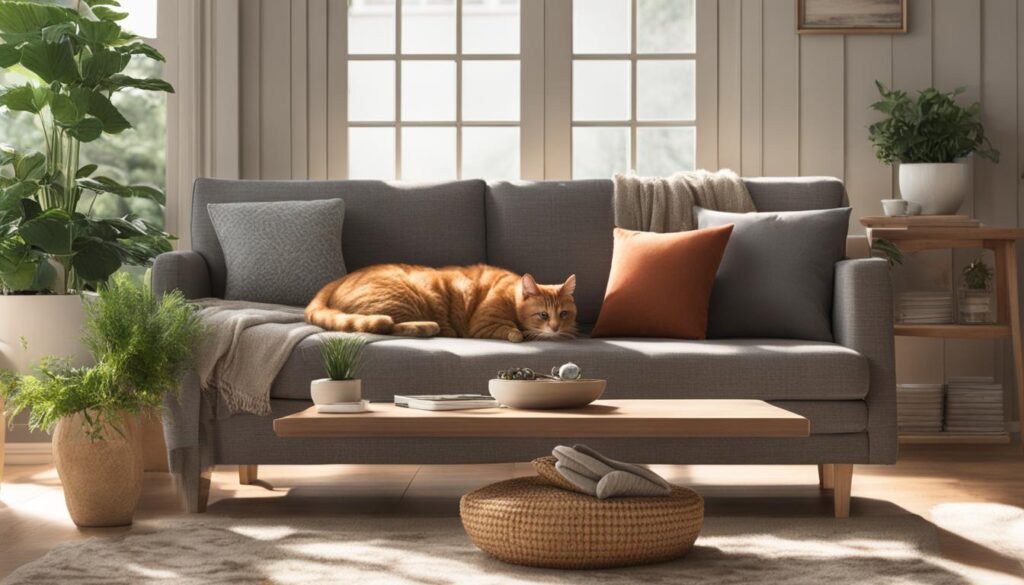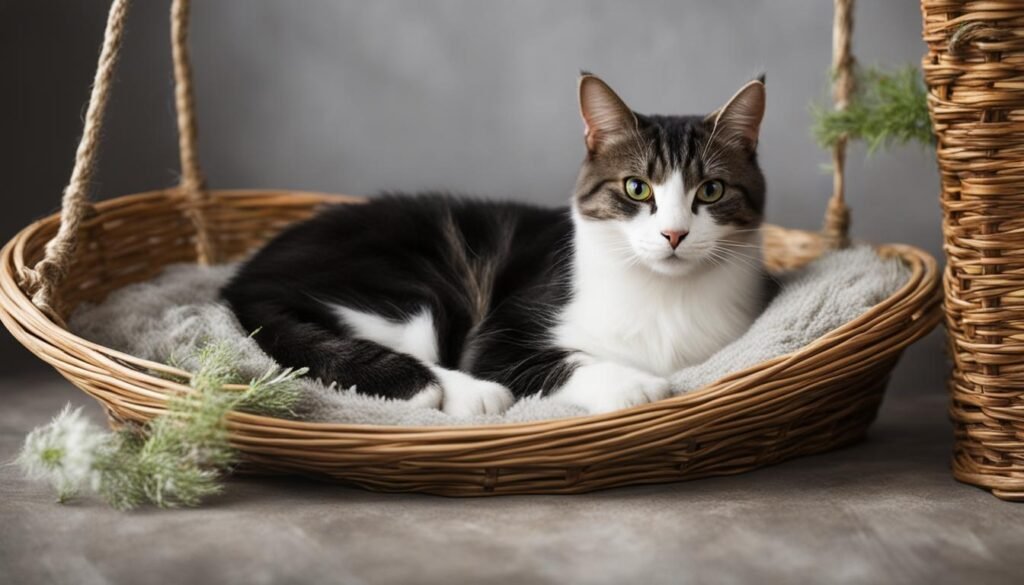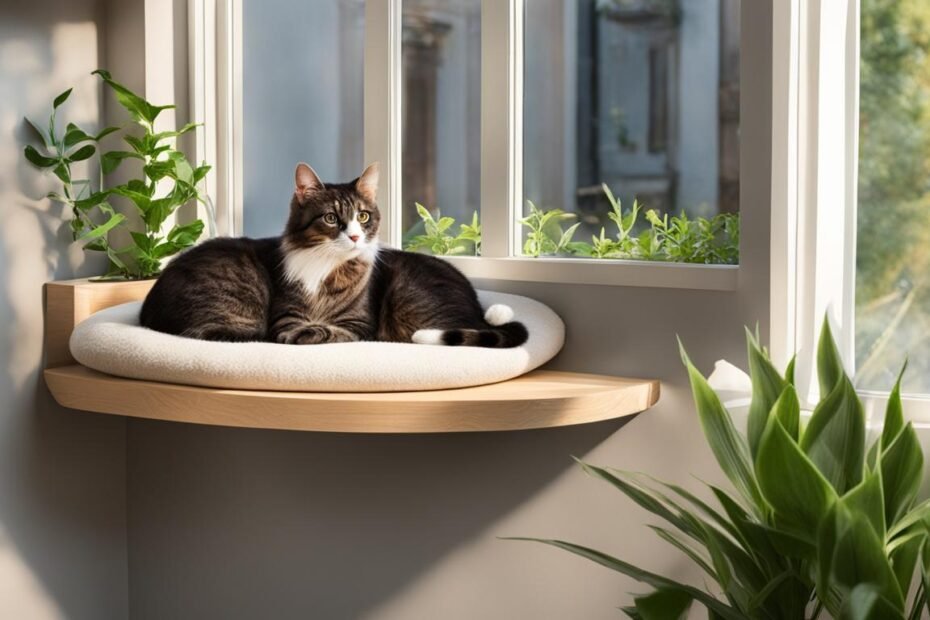Welcome, cat owners! Creating a cat-friendly home is not only important for your feline friend’s well-being but also for their overall happiness. By providing cat-safe spaces and personalized cat zones, you can ensure that your cat feels secure and content in their environment. This essential guide will walk you through the steps to create the perfect cat-friendly home that meets your cat’s specific needs.
Key Takeaways:
- Creating a cat-friendly home is essential for your cat’s happiness and well-being.
- Personalized cat zones provide a sense of ownership and territory for your cat.
- Cat-proofing your home eliminates potential hazards and ensures a safe environment.
- High resting places and hiding spots satisfy your cat’s need for surveillance and security.
- A cat-friendly toilet area with a suitable litter tray promotes good hygiene and renal health.
Cat-Proofing Your Home: Ensuring a Safe Environment
When it comes to creating a cat-friendly home, cat-proofing is a crucial step in ensuring your furry friend’s safety. By identifying and eliminating potential hazards, you can provide a secure environment for your cat to explore and play in. Let’s take a look at some common hazards and how to address them:
Potential Hazards
One of the first things to consider is the presence of toxic plants in your home. Cats are curious creatures and may be tempted to nibble on certain plants, which can be harmful or even fatal. Research which plants are toxic to cats and remove them from your home or place them out of reach.
Dangling wires also pose a risk to your cat’s safety. Cats are known for their love of play, and wires can easily become a target. Secure loose wires or invest in cord protectors to prevent your cat from chewing on them and potentially getting electrocuted.

Hot hobs in the kitchen can also be dangerous for cats. Always be mindful of where your cat is when cooking, and use back burners whenever possible. This simple precaution can prevent accidental burns and injuries to your feline companion.
Creating a Safe Environment
Aside from eliminating potential hazards, there are other steps you can take to create a safe environment for your cat. Consider creating designated play areas and providing plenty of toys to keep your cat entertained and prevent them from getting into trouble in other parts of the house.
Additionally, providing secure hiding spots such as cat condos or enclosed beds can give your cat a place to retreat to when they feel overwhelmed or stressed. These hiding spots can provide a sense of security and help your cat feel more at ease in their environment.
A Safe and Happy Home
By cat-proofing your home and taking necessary precautions, you can create a safe and happy environment for your feline companion. Remember to stay vigilant and regularly assess your home for any new potential hazards that may arise. Your cat’s well-being and safety should always be a top priority.
Establishing Boundaries and Personalized Cat Zones
Creating boundaries and personalized cat zones in your home is crucial to promoting your cat’s well-being and ensuring their comfort and happiness. By providing designated spaces tailored to their needs, you can help your cat feel a sense of ownership and territory, reducing any potential stress or anxiety. Here are some essential tips for establishing boundaries and personalized cat zones:
1. Define Cat-Friendly Spaces
Start by identifying specific areas in your home that can be designated as cat-friendly spaces. These can include a corner in the living room, a dedicated room, or even specific pieces of cat furniture. The key is to choose areas that are easily accessible to your cat and can provide them with a sense of security and relaxation.
2. Cat’s Essentials
Ensure that your cat’s essentials such as food and water bowls, litter box, and bed are conveniently located within their personalized cat zone. This will help establish a routine and make it easier for your cat to find and access these essential items.
Also, consider adding scratching posts, toys, and interactive games within their zone to provide mental stimulation and promote physical exercise. These additions will help keep your cat entertained and satisfied.
3. Observing Cat Interactions
Take the time to observe how your cats interact with each other, especially if you have multiple cats. Some cats may prefer to have their own space away from other feline companions. By noticing their behavior and body language, you can ensure that each cat has their own territory and does not feel threatened by others.
“Providing designated personalized cat zones not only helps create boundaries but also allows cats to establish their own territory, reducing any potential conflicts.”
Remember to respect your cat’s boundaries and avoid forcing them into unfamiliar spaces. Allow them to explore and adjust at their own pace, ensuring they have a safe and comfortable environment to thrive.
Creating boundaries and personalized cat zones in your home is an investment in your cat’s well-being. It provides them with a sense of security, ownership, and territory, ultimately contributing to their overall happiness and contentment. By following these tips, you can create an environment that fulfills your cat’s essential needs and allows them to flourish.
Providing Resting Places and Hiding Spots
Cats are known for their love of heights and their desire for safe, enclosed spaces. By providing high resting places and hiding spots, you can fulfill these natural feline instincts and help your cat feel secure and comfortable in their environment.
One option for high resting places is cat furniture or shelves. These elevated spaces give cats a sense of security and allow them to survey their surroundings from a vantage point. Whether it’s a tall scratching post or a wall-mounted shelf, these elevated perches provide a cozy spot for your cat to relax and observe their kingdom.
Additionally, creating safe havens in the form of hiding spots is essential for your cat’s well-being. Enclosed beds, tepees, or even cardboard boxes lined with blankets can serve as perfect hiding spots for your feline friend. These spaces offer a retreat where your cat can retreat to when they need some alone time or want to escape from a busy household.
“Having high resting places and hiding spots for cats is crucial to their mental and emotional well-being. It allows them to fulfill their natural instincts of perching and seeking enclosed spaces, creating a stress-free environment for them.” – Dr. Emily Johnson, Feline Behavior Specialist
Remember to place these resting places and hiding spots strategically throughout your home, ensuring that your cat has access to them in various areas. This will give them the freedom to choose where they feel most comfortable, whether it’s in a sunny spot by the window or in a quiet corner away from the hustle and bustle.
| Benefits of High Resting Places and Hiding Spots | Examples |
|---|---|
| 1. Provides a sense of security and safety | Wall-mounted shelves |
| 2. Allows cats to survey their surroundings | Tall scratching posts |
| 3. Offers a retreat for alone time | Enclosed beds |
| 4. Reduces stress and anxiety | Tepees |
By incorporating high resting places and hiding spots into your home, you are creating an enriched environment that supports your cat’s natural behaviors and preferences. These spaces provide them with the comfort and security they need to thrive, resulting in a happier and healthier feline companion.

Creating a Cat-Friendly Toilet Area
Your cat’s toilet area is an essential part of their daily routine. Providing a comfortable and hygienic space for them to do their business is crucial for their overall well-being. Here are some tips to create a cat-friendly toilet area:
Choose the Right Litter Tray
When it comes to choosing a litter tray, consider your cat’s preferences. Some cats prefer covered trays for privacy, while others prefer open trays that offer a clear view of their surroundings. Ensure that the litter tray is large enough for your cat to move around comfortably and deep enough to prevent litter from spilling out.
Multiple Cats, Multiple Trays
If you have multiple cats, it’s important to provide a separate litter tray for each cat. Cats are territorial animals, and having their own designated space to use the bathroom can help reduce stress and potential conflicts between them. Place the litter trays in different areas of your home to provide easy access for each cat.
Consider a Cat Water Fountain
In addition to the litter tray, consider adding a cat water fountain to the toilet area. Cats are more likely to drink water if it’s fresh and flowing, and a fountain can encourage them to stay hydrated. Make sure to clean and refill the fountain regularly to keep the water fresh and enticing for your cat.
| Litter Tray Types | Advantages | Disadvantages |
|---|---|---|
| Open Tray | – Provides a clear view | – Less privacy |
| Covered Tray | – Offers privacy | – May trap odors |
| Automatic Self-Cleaning Tray | – Reduces scooping | – Expensive |
Creating a cat-friendly toilet area is an integral part of ensuring your cat’s comfort and hygiene. By choosing the right litter tray, providing multiple trays for multiple cats, and considering a cat water fountain, you can create a space that meets your cat’s needs and promotes good bathroom habits.
Conclusion
Creating cat-safe spaces in your home is paramount to ensuring your cat’s happiness and well-being. By providing a safe environment, establishing boundaries, and offering personalized cat zones, you can guarantee that your feline friend feels secure and content.
Moreover, incorporating high resting places, hiding spots, and a cat-friendly toilet area will further enhance your cat’s quality of life. These additions not only provide environmental enrichment but also meet their specific needs.
A cat-friendly home that promotes cat happiness and provides a comfortable living space is essential for your feline companion. By prioritizing their safety and well-being, you can establish an environment where they can thrive and be their truest selves.
FAQ
Why is cat-proofing my home important?
Cat-proofing your home is crucial to prevent accidents or injuries to your cat. By eliminating potential hazards such as toxic plants, dangling wires, and hot hobs, you can create a safe environment for your cat to explore and thrive in.
How do I establish boundaries and personalized cat zones?
To establish boundaries and personalized cat zones, keep your cat’s essentials in the same spot, such as their bowls, bed, and litter tray. Observe how your cats interact with each other to ensure each cat has their own space and does not feel threatened by others.
What are some options for providing resting places and hiding spots for my cat?
Cats love to perch up high and have safe havens to hide in. Providing high resting places such as cat furniture or shelves, and enclosed beds, tepees, or cardboard boxes lined with blankets can serve as safe hiding spots for your cat, allowing them to feel safe and comfortable in their environment.
How can I create a cat-friendly toilet area?
Choose the right litter tray management system that suits your cat’s preferences. Provide a separate litter tray for each cat or an extra deep and large tray for multiple cats. Consider using a pet water fountain to encourage your cat to drink more water for good kidney function.
Why is creating cat-safe spaces important?
Creating cat-safe spaces in your home is essential for your cat’s happiness and well-being. It provides a secure and comfortable environment that meets their specific needs and enhances their quality of life.
